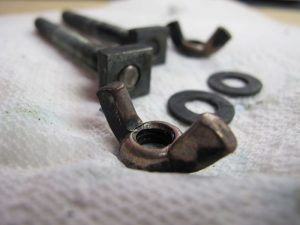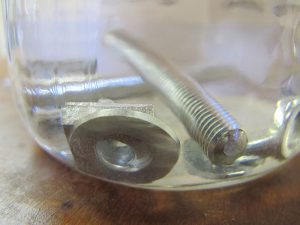We may receive a commission when you use our affiliate links. However, this does not impact our recommendations.
I’ve used a lot of different methods to add age to my hardware – everything from a propane torch to ammonia to gun blue to (yes) human urine.
Whenever I discuss these methods, I get complaints. So in an effort to garner more complaints, here’s another one: Jax Chemicals. These are the formulas that metalsmiths use to add patina to their work and were recommended to me by a couple of woodworkers.
I ordered some last week (Smythe disclaimer here, blah, blah, blah) with my very own money and put them to use today to age some steel hardware for some Roorkhee chairs I’m building for the magazine.
Jax makes a variety of formulas. I ordered the “Antique Rust” for the steel parts and “Jax Brown” for brass, bronze and copper, which I’ll report on some other time. Let’s talk about the stuff for steel.
All the steel parts were coated with something – lacquer perhaps – and so I soaked the metal parts for an hour in lacquer thinner and then scrubbed them with a woven pad. (Safety note: all these solvents are nasty, especially lacquer thinner. Getting it on your skin is bad. Wear solvent-resistant gloves – the best you can afford.)
Then, as per the instructions on the container, I applied the Jax solution with a stiff-bristled brush.
And… nothing.
I scrubbed the parts some more and then dumped the parts in the Jax solution, which I had poured into a plastic cup (as per the instructions). It looked like something was almost happening in there.
Still wearing the gloves, I fished the parts out of the Jax solution and took a bronze-bristle brush to the parts, brushing the stuff on with some prejudice. Bingo. The parts quickly turned a nasty blackish brownish color.
When I rubbed my wing nuts (no jokes, please) I actually discovered they were brass or bronze under a thin plating. I rubbed through the plating in some points, left the black in others. All in all, I liked the final look.
I then threaded the hardware onto the chairs and was much more at peace with myself. The hardware faded into the background of the piece instead of poking me in the eye with its shiny, galvanized appearance.
I like the Jax stuff, and it’s handy if you don’t like fire (scarecrow) or dousing your hardware in 20 proof hobo solution.
— Christopher Schwarz
Check out the chair this hardware is for here.
Here are some supplies and tools we find essential in our everyday work around the shop. We may receive a commission from sales referred by our links; however, we have carefully selected these products for their usefulness and quality.












Mr. Schwartz
Twice now you have referred to the “Smythe disclaimer” in your blog. This stems no doubt from my comments earlier concerning the true cost of your building (and outfitting)campaign furniture. I’m somewhat flattered by your persistance in continuing your “truth in purchasing” disclaimer with reference to me – however sardonic. Still, if it is your intention to continue using a named disclaimer I would appreciate it if you had the courtesy to spell my name correctly. My name is spelled Smyth, not Smythe.
Gary Smyth, Ph.D.
Some good ideas. I’ve just been using muriatic acid to remove whatever coating is on iron parts then leaving them in salty water for a few days. The rust is very real. You have to move the parts around in the water a few times because they don’t like to rust as quickly when they are under water so I leave them half covered then shake them around after a few hours. Not sure what this would do to brass, etc.
I know one woodworker who takes his screws to attach table tops and puts them in a 1 lb coffee can, and puts the can in the middle of either his fireplace fire in winter, or a campfire/firepit if its not winter. Burns all the crud off the hardware, and the screws look like they are 200 years old.
Here’s how I age my hardware: I wait.
Here’s how I distress my furniture: I use it.
I realize this is a much bigger and more convoluted subject than just those two simple and provocative statements. Mike Dunbar wrote a series of articles on this subject for PWM about a year or two ago, and I respect each and everyone’s right to do what ever they think best (“Disobey me” – heard that before?), but – in my opinion – badly done fake distressing/aging looks a *lot” worse than bright and shiny.
Another thought – if your brand new Windsor chair/campaign chest/outhouse looks 200 years old now, what’s it going to look like in 200 years time?
I’ve had good luck with several proprietary products from Birchwood-Casey and plain old lye. They’re treating lye like antihistamines nowadays so you have to have someone go into the back of the store to get it and you have to sign something that says you are NOT a meth lab owner. But it’s worth it and lye will remove pitch off blades better than ANYTHING else on the planet. Learned that from my commercial sharpening service.
The lye will turn brass dark and will burnish out using 0000 steel wool to reveal some really nice blues to browns and even a little purple in between the highlights or brass. Schweeeet.
” (Smythe disclaimer here, blah, blah, blah)” lol…
Chris,
I’m so relieved to know you used your own money! 😉
Leslie
Hey Chris,
In addition to the plastic/lacquer/clear coating, the Jax solution may not penetrate the nickel/zinc plating well. The description on the Jax website does not specifically mention nickel for their “Brown” product, but it does for the “Pewter Black” (maybe others too?). So, maybe just selecting a different Jax solution would work better?
Russ
Hey Chris,
I’m surprised you haven’t found this hardware supply:
http://www.blacksmithbolt.com/index.html
They carry NO hex head, Phillips or zinc plated crap. They have bronze screws and IRON rivets.
Now you can FINALLY stop peeing on your hardware, next we’ll work on quitting that nail-biting.